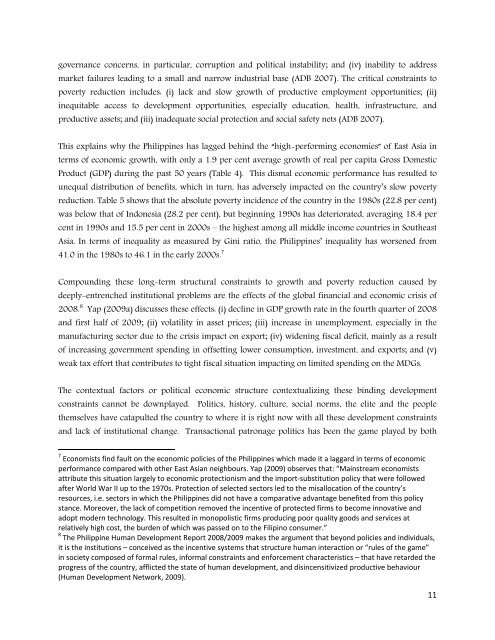Triangulation Framework for Local Service Delivery - Philippine ...
Triangulation Framework for Local Service Delivery - Philippine ...
Triangulation Framework for Local Service Delivery - Philippine ...
Create successful ePaper yourself
Turn your PDF publications into a flip-book with our unique Google optimized e-Paper software.
governance concerns, in particular, corruption and political instability; and (iv) inability to address<br />
market failures leading to a small and narrow industrial base (ADB 2007). The critical constraints to<br />
poverty reduction includes: (i) lack and slow growth of productive employment opportunities; (ii)<br />
inequitable access to development opportunities, especially education, health, infrastructure, and<br />
productive assets; and (iii) inadequate social protection and social safety nets (ADB 2007).<br />
This explains why the <strong>Philippine</strong>s has lagged behind the “high-per<strong>for</strong>ming economies” of East Asia in<br />
terms of economic growth, with only a 1.9 per cent average growth of real per capita Gross Domestic<br />
Product (GDP) during the past 50 years (Table 4). This dismal economic per<strong>for</strong>mance has resulted to<br />
unequal distribution of benefits, which in turn, has adversely impacted on the country’s slow poverty<br />
reduction. Table 5 shows that the absolute poverty incidence of the country in the 1980s (22.8 per cent)<br />
was below that of Indonesia (28.2 per cent), but beginning 1990s has deteriorated, averaging 18.4 per<br />
cent in 1990s and 15.5 per cent in 2000s – the highest among all middle income countries in Southeast<br />
Asia. In terms of inequality as measured by Gini ratio, the <strong>Philippine</strong>s’ inequality has worsened from<br />
41.0 in the 1980s to 46.1 in the early 2000s. 7<br />
Compounding these long-term structural constraints to growth and poverty reduction caused by<br />
deeply-entrenched institutional problems are the effects of the global financial and economic crisis of<br />
2008. 8 Yap (2009a) discusses these effects: (i) decline in GDP growth rate in the fourth quarter of 2008<br />
and first half of 2009; (ii) volatility in asset prices; (iii) increase in unemployment, especially in the<br />
manufacturing sector due to the crisis impact on export; (iv) widening fiscal deficit, mainly as a result<br />
of increasing government spending in offsetting lower consumption, investment, and exports; and (v)<br />
weak tax ef<strong>for</strong>t that contributes to tight fiscal situation impacting on limited spending on the MDGs.<br />
The contextual factors or political economic structure contextualizing these binding development<br />
constraints cannot be downplayed. Politics, history, culture, social norms, the elite and the people<br />
themselves have catapulted the country to where it is right now with all these development constraints<br />
and lack of institutional change. Transactional patronage politics has been the game played by both<br />
7 Economists find fault on the economic policies of the <strong>Philippine</strong>s which made it a laggard in terms of economic<br />
per<strong>for</strong>mance compared with other East Asian neighbours. Yap (2009) observes that: “Mainstream economists<br />
attribute this situation largely to economic protectionism and the import‐substitution policy that were followed<br />
after World War II up to the 1970s. Protection of selected sectors led to the misallocation of the country’s<br />
resources, i.e. sectors in which the <strong>Philippine</strong>s did not have a comparative advantage benefited from this policy<br />
stance. Moreover, the lack of competition removed the incentive of protected firms to become innovative and<br />
adopt modern technology. This resulted in monopolistic firms producing poor quality goods and services at<br />
relatively high cost, the burden of which was passed on to the Filipino consumer.”<br />
8 The <strong>Philippine</strong> Human Development Report 2008/2009 makes the argument that beyond policies and individuals,<br />
it is the institutions – conceived as the incentive systems that structure human interaction or “rules of the game”<br />
in society composed of <strong>for</strong>mal rules, in<strong>for</strong>mal constraints and en<strong>for</strong>cement characteristics – that have retarded the<br />
progress of the country, afflicted the state of human development, and disincensitivized productive behaviour<br />
(Human Development Network, 2009).<br />
11










